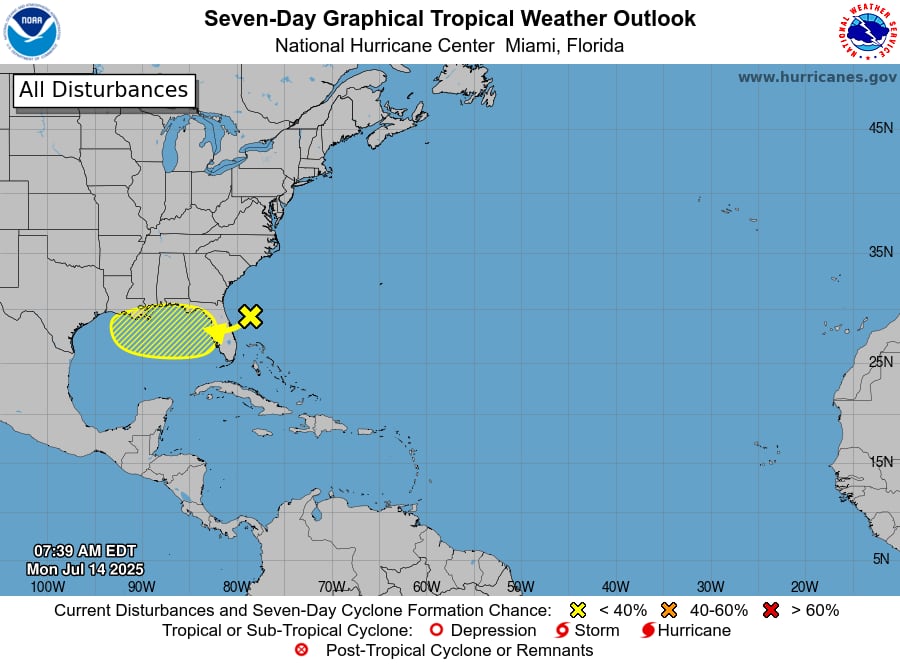At 4:40 p.m. on Friday, the National Weather Service issued a weather notice for DeKalb County, predicting heavy thunderstorms through 5:30 p.m.
Expect pea-sized hail (0.25 inches) and wind gusts of up to 40 mph.
“At 4:40 p.m., Doppler radar tracked a strong thunderstorm near Summerville, moving southwest at 15 mph,” according to the meteorological service. Gusty winds have the potential to blow around unsecured objects and topple tree branches. There is a chance of minor hail damage to vegetation.
Fort Payne, Henagar, Ider, Valley Head, Hammondville, Mentone, Sulpher Springs, Desoto State Park, and Little River Canyon National Park are among the places affected by the alert.
“If outside, consider seeking shelter inside a building,” the weather agency advises. This storm is causing frequent lightning strikes from the clouds to the ground. Ten miles can separate a thunderstorm from a lightning strike. Look for a secure place to hide inside a building or car.
When lightning looms: Expert safety tips for thunderstorms
Approximately 25 million lightning strikes occur in the United States annually, with the majority of these electrical discharges taking place in the summer. Unfortunately, according to the weather service, lightning kills roughly 20 people every year. As thunderstorms approach, the likelihood of lightning-related incidents increases, peaking when the storm is directly overhead. But as the tempest sweeps away, it gradually fades away.
In order to ensure your safety during a thunderstorm, consider the following suggestions:
Plan for lightning safety:
-
When venturing outdoors, it’s vital to establish a clear plan for seeking shelter in case of lightning.
-
Stay vigilant by monitoring the sky for ominous signs and listening for the telltale sound of thunder. If thunder is audible, it’s a clear indication of nearby lightning.
-
Seek a safe place to shelter, preferably indoors.
Indoor safety precautions:
-
Once you’re indoors, avoid using corded phones, electrical devices, plumbing fixtures, and stay away from windows and doors.
-
Lightning can follow conductive pathways, and these precautions reduce the risk of electrical surges.
Hold off till the all-clear:
-
After the last lightning strike or thunderclap, wait at least 30 minutes before resuming outdoor activities.
-
It’s important to remember that lightning can strike even when a storm seems to have passed, so exercise caution.
When there is no indoor shelter:
Take these precautions to increase your safety if you are outside during a thunderstorm without access to inside shelter:
-
Avoid open fields, hilltops, or ridge crests, as they expose you to greater lightning risk.
-
Steer clear of tall, isolated trees and other prominent objects. In wooded areas, stay close to lower stands of trees.
-
If you’re in a group, ensure that individuals are spaced out to prevent lightning current from transferring between people.
-
Camping in an open setting during a thunderstorm is strongly discouraged. If no alternative exists, set up camp in a valley, ravine, or other low-lying areas. Remember that a tent offers no protection against lightning.
-
Do not approach water bodies, wet objects, or metal items. Although water and metal do not attract lightning, they conduct electricity effectively and can pose significant risks.
In conclusion, being alert and ready are your best defenses against lightning threats. You may put your safety first and drastically lower the likelihood of lightning-related mishaps by adhering to these rules.
Navigating rainy roads: Safety tips for wet weather
If heavy rainfall persists or if runoff is substantial, flooding may result. Saturated soils and/or heavy rainfall can cause excessive runoff. To keep safe during periods of intense rain, heed these weather service recommendations:
Watch out for swift water flow:
Avoid parking or strolling close to drainage ditches or culverts during periods of intense rain, since the swift-moving water can be quite dangerous.
Keep your distances from other vehicles safe:
In heavy rain, the two-second rule of following distance is your friend. To guarantee safe spacing under unfavorable circumstances, increase it to four seconds.
Reduce your speed and drive carefully:
It’s crucial to slow down on wet roads. To avoid sliding, reduce the accelerator gradually and don’t brake suddenly.
Pick your lane carefully:
Water tends to pool in the outside lanes, so stick to the central ones.
Put visibility first.
As rain-spattered windows make it more difficult to see other vehicles, turn on your headlights and pay attention to those in blind spots and behind you.
Be cautious on slick roads:
Because of a combination of rain, oil, and grime, roadways are at their slickest during the first 30 minutes of precipitation. Be especially careful during this time.
Stay a safe distance away from big cars:
Tire spray from big vehicles and buses can make it harder to see. Pass them quickly and safely, and refrain from tailgating.
Be mindful of your wipers:
The wiper blades may be overloaded by heavy rain. It’s time to stop and wait for the rain to stop when visibility is so poor that you can’t see other cars or the road’s borders from a safe distance. Stopping at rest areas or other sheltered spaces is the best option.
Position your car as far off the road as you can, preferably beyond guardrails, if stopping by the side of the road is your only choice. To let other cars know where you are, turn on your emergency flashers and keep your headlights on.
Taking these safety measures will significantly improve your road safety while it’s raining a lot. For a safe trip, keep yourself updated on weather conditions and follow local authorities’ instructions.
United Robots offers a service called Advance Local Weather Alerts that gathers the most recent information from the National Weather Service using machine learning.



